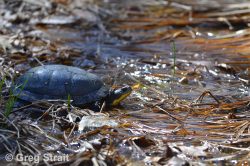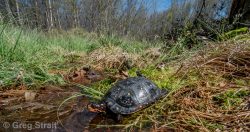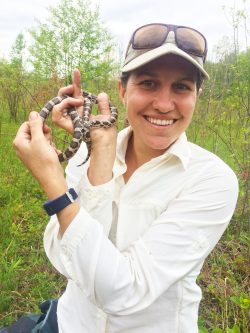The U.S. is home to a rich variety of freshwater turtles (approximately 18% of the world’s turtles). Some of these turtles are endangered or threatened due to illegal collection and trade. Habitat loss and wetland conversion also threaten most. Out of Ohio’s twelve turtle species, two are listed as state-threatened (Spotted and Blanding’s) and may require agency coordination to complete your project or conduct conservation work. The U.S. Fish and Wildlife Service has been petitioned to Federally list both species and their status has been under review since 2015. Spotted and Blanding’s Turtles also have varying state protections across their ranges and our experienced herpetologists have scientific collection permits and are experts at detecting them in their habitats.
Spotted Turtle (Clemmys guttata)
U.S. Range: CT, DE, FL, GA, IL, IN, ME, MD, MA, MI, PA, NH, NY, NC, OH, SC, VT, VA, and WV
Spotted Turtles occupy a diversity of shallow wetlands; marshes, wet meadows, ponds, forested and shrub swamps, bogs, fens, shallow slow-moving streams, vernal pools, and even drainage ditches. Individuals will often use multiple small wetlands throughout their activity period. Wetland requirements include a soft substrate, aquatic or emergent vegetation, and at least a partially open canopy. In some populations, during certain times of the year, up to 74% of a Spotted Turtles’ activity period is spent in upland habitats. An increased activity period typically occurs in April and May, but is temperature dependent. Nesting in early successional, open canopied uplands (both natural and human altered) or hummocks in emergent wetlands is typically completed by July. Nests are placed in well-drained areas exposed to full sunlight. Estivation often follows the nesting period, in association with high summer temperatures, where Spotted Turtles become relatively inactive while resting in the bottoms of wetlands or in depressions of organic soils, leaf litter, root masses, stump holes, etc. Hatchlings emerge in August or September, but may overwinter in the nest. Spotted Turtles typically enter hibernation in or near their spring occupied wetland by mid-October.
If your project returns potential occurrence of Spotted Turtles, the first step will be for an Ohio Department of Natural Resources Approved Herpetologist to conduct a habitat survey. If habitat is designated, then a presence/absence and/or exclusion survey can be coordinated to assist with project approval and completion. Inventory and monitoring efforts can be completed by EnviroScience herpetologists for land managers who are interested in researching and protecting these animals as well.
For more information on Spotted Turtle Conservation in Ohio see: https://www.leapbio.org/resources/spotted-turtle
Blanding’s Turtle (Emydoidea blandingii)
 U.S. Range: IL, IA, IN, ME, MA, MI, MN, MO, NH, NY, NE, OH, PA, SD, and WI
U.S. Range: IL, IA, IN, ME, MA, MI, MN, MO, NH, NY, NE, OH, PA, SD, and WI
Blanding’s Turtles need both wetland and upland habitats to complete all aspects of their life history. These wetland habitats include ponds, marshes and marshy shorelines, shrub swamps, wet meadows, and ditches and streams with slow-moving water. Wetlands with mud bottoms and abundant aquatic vegetation are preferred, and extensive marshes bordering lakes and/or rivers provide good habitat. Small temporary wetlands (those that dry up in the late summer or fall) can be used in spring and summer. These fishless pools are amphibian and invertebrate breeding habitat, which provides an important food source. Also, the warmer water of these shallower areas may aid in the development of eggs within the female turtle. Nesting occurs primarily in June in open sandy or loamy uplands with interspersed vegetation, often a considerable distance from the wetland habitat. Ideally, nesting occurs in traditional nesting grounds on undeveloped land. Blanding’s Turtles, however, have also been known to nest successfully on residential property, and to utilize disturbed areas such as farm fields, gardens, under power lines, and road shoulders. Wetlands with deeper water are needed in times of drought and for overwintering habitat where they are protected from freezing.
If your project returns potential occurrence of Blanding’s Turtles, the first step will be for an Ohio Department of Natural Resources Approved Herpetologist to conduct a habitat survey. If habitat is designated, then a presence/absence and/or exclusion survey can be coordinated to assist with project approval and completion. Inventory and monitoring efforts can be completed by EnviroScience herpetologists for land managers who are interested in researching and protecting these animals as well.
Questions? Contact our Herpetologist Teal Richards-Dimitrie at TRichards-Dimitrie @ EnviroScienceInc.com.




